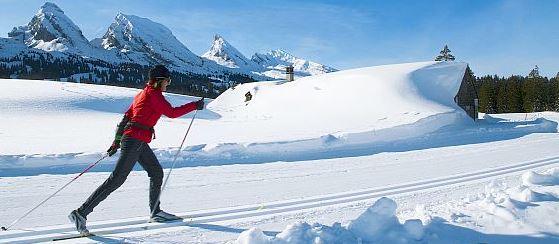For some athletes, there is nothing better than gliding on a freshly groomed trail after the first snowfall. However, caution is advised on bitterly cold days, especially when it is early in the morning. Among other hazards, you must be careful not to damage your lungs. This can happen when you haven’t properly warmed up and your exercise is to vigorous right away. If this happens, you may need to rest and take time off training. If you continue with normal training and ignore damaged lungs, you run the risk of developing nasal drip, a hacking cough, a sore throat, or a worse condition like exercise induced asthma.

Disorders of the respiratory system
Because we spend most of the winter months indoors with warm forced heated air, the mucous membranes of our lungs can become irritated. As a result, our natural defense barrier to viruses and bacteria is weakened. Cold outside air intensifies this effect. It does this because the temperature in the area of our upper respiratory tract, which remains constant during average outdoor temperatures, falls under very cold ambient temperatures. One way for athletes to help alleviate this problem is to breathe through the nose. It cleans the air, warms it to body temperature and saturates it with steam. Cold, dry air can also cause an increase in mucus in your nasal passages.
Prevention of respiratory illnesses
When temperatures turn very cold, shortening your training time and reducing the intensity of those efforts will help to prevent illnesses. A good warmup starting very slowly with a gradual increase in running tempo is very important. A scarf pulled up over the mouth and nose can also help to warm and humidify the cold air. There are also commercially produced air warming products (masks) used by some top athletes who train regularly at cold temperatures. However, these masks can not be used in competition though as they increase breathing resistance. Functional clothing, that wicks moisture away from the skin and protects you against the chill of the wind, is absolutely necessary. If it’s just too cold, try to train indoors on a treadmill.
Exercise-induced asthma
If you cough, wheeze or feel out of breath during or after exercise, it may be more than exertion causing your symptoms. You might have exercise-induced asthma. As with asthma triggered by other things, exercise-induced asthma symptoms occur when your airways tighten and produce extra mucus. This can often occur when the temperatures drop. However, having exercise-induced asthma doesn’t mean you shouldn’t exercise. Proper treatment of exercise-induced asthma and precautions can keep you active —whether you’re taking a walk or running a race. Again, a proper warm up is crucial along with following your doctor’s prescription for inhalers or other therapies.
Fluid Intake
Under cold conditions, athletes often lose from 3-8% of their body weight during long duration exercise. The reasons for this could be: excess fluid loss through sweating or respiration, a suppressed sense of thirst, cold-induced urinary urgency, and limited access to fluids. These things can lead to dehydration, which becomes even worse at altitude. For this reason, you should carefully monitor your fluid intake before, during and after your workouts.

Cardiovascular
In cold weather, the body needs more energy to maintain a constant normal body temperature of 98.6º degrees Fahrenheit. Therefore, functional sports clothing is especially important in the winter. Cold causes a narrowing of the blood vessels in the body and an increase in blood pressure. As a result, the heart beats faster and pumps more blood through the body. This explains why people with clogged coronary arteries often experience angina, or chest pain, while exercising in the winter.
Conclusion
Exercise during the winter months is basically no problem as long as you heed some of the basic advice suggested here. Before your workout plan accordingly with extra fluid intake and proper clothing (dress in layers of functional, moisture wicking material with wind protection). Start your run with an extended very gradual warm up before any intense effort is performed. Wear a scarf or other breathing preheating system to help protect your respiratory tract. Keep up with fluids during your workout. People with heart disease, high blood pressure or exercise induced asthma need to heed their doctors advice.
Sometimes, it’s just too cold to be safe. The Medical Commission of the International Ski Federation (FIS) has the following temperature limits for the carrying out of competitions:
- Long distance races that are greater than 30 km: 3°F
- Shorter distances of less than 30 km: 0°F
- Sprint race: -4°F
- Children racing under the age of 14 years: 10° F
This blog was written by Dr. Patrik Noack, Medbase St. Gallen SUI.
